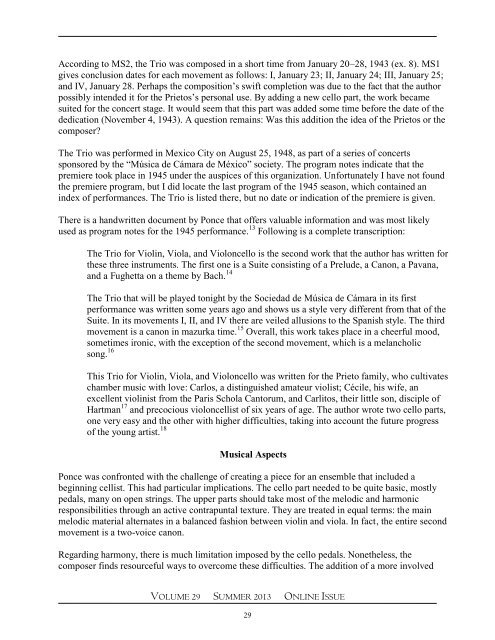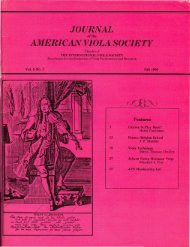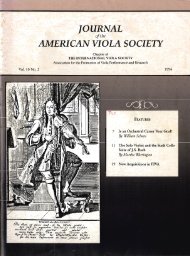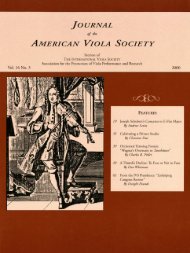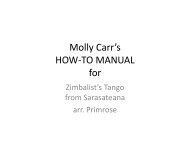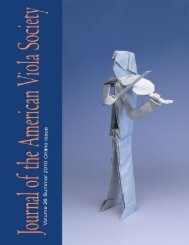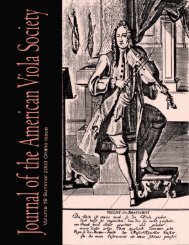Summer 2013 - The American Viola Society
Summer 2013 - The American Viola Society
Summer 2013 - The American Viola Society
Create successful ePaper yourself
Turn your PDF publications into a flip-book with our unique Google optimized e-Paper software.
According to MS2, the Trio was composed in a short time from January 20–28, 1943 (ex. 8). MS1<br />
gives conclusion dates for each movement as follows: I, January 23; II, January 24; III, January 25;<br />
and IV, January 28. Perhaps the composition’s swift completion was due to the fact that the author<br />
possibly intended it for the Prietos’s personal use. By adding a new cello part, the work became<br />
suited for the concert stage. It would seem that this part was added some time before the date of the<br />
dedication (November 4, 1943). A question remains: Was this addition the idea of the Prietos or the<br />
composer?<br />
<strong>The</strong> Trio was performed in Mexico City on August 25, 1948, as part of a series of concerts<br />
sponsored by the “Música de Cámara de México” society. <strong>The</strong> program notes indicate that the<br />
premiere took place in 1945 under the auspices of this organization. Unfortunately I have not found<br />
the premiere program, but I did locate the last program of the 1945 season, which contained an<br />
index of performances. <strong>The</strong> Trio is listed there, but no date or indication of the premiere is given.<br />
<strong>The</strong>re is a handwritten document by Ponce that offers valuable information and was most likely<br />
used as program notes for the 1945 performance. 13 Following is a complete transcription:<br />
<strong>The</strong> Trio for Violin, <strong>Viola</strong>, and Violoncello is the second work that the author has written for<br />
these three instruments. <strong>The</strong> first one is a Suite consisting of a Prelude, a Canon, a Pavana,<br />
and a Fughetta on a theme by Bach. 14<br />
<strong>The</strong> Trio that will be played tonight by the Sociedad de Música de Cámara in its first<br />
performance was written some years ago and shows us a style very different from that of the<br />
Suite. In its movements I, II, and IV there are veiled allusions to the Spanish style. <strong>The</strong> third<br />
movement is a canon in mazurka time. 15 Overall, this work takes place in a cheerful mood,<br />
sometimes ironic, with the exception of the second movement, which is a melancholic<br />
song. 16<br />
This Trio for Violin, <strong>Viola</strong>, and Violoncello was written for the Prieto family, who cultivates<br />
chamber music with love: Carlos, a distinguished amateur violist; Cécile, his wife, an<br />
excellent violinist from the Paris Schola Cantorum, and Carlitos, their little son, disciple of<br />
Hartman 17 and precocious violoncellist of six years of age. <strong>The</strong> author wrote two cello parts,<br />
one very easy and the other with higher difficulties, taking into account the future progress<br />
of the young artist. 18<br />
Musical Aspects<br />
Ponce was confronted with the challenge of creating a piece for an ensemble that included a<br />
beginning cellist. This had particular implications. <strong>The</strong> cello part needed to be quite basic, mostly<br />
pedals, many on open strings. <strong>The</strong> upper parts should take most of the melodic and harmonic<br />
responsibilities through an active contrapuntal texture. <strong>The</strong>y are treated in equal terms: the main<br />
melodic material alternates in a balanced fashion between violin and viola. In fact, the entire second<br />
movement is a two-voice canon.<br />
Regarding harmony, there is much limitation imposed by the cello pedals. Nonetheless, the<br />
composer finds resourceful ways to overcome these difficulties. <strong>The</strong> addition of a more involved<br />
VOLUME 29 SUMMER <strong>2013</strong> ONLINE ISSUE<br />
29


